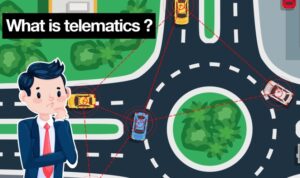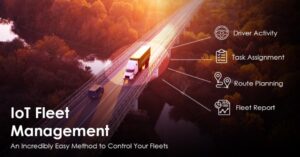Technology is changing the way we live with Artificial knowledge (AI) leading the way. AI is the leader bringing new ideas and incorporating knowledge into everyday tasks. Imagine using this intelligence not only for its own sake, but also to help fleet management. This article goes into great detail on how AI and telematics systems can work together. It helps us make fleet operations more successful and efficient. With AI in telematics, fleet management is entering a new era of possibilities. For example, it can predict when the fleet needs repair and find the best routes. Come with us as we explore the possibilities that lie ahead where AI meets the future of fleet management.

1. Predictive Analytics for Proactive Fleet Management
In the past, telematics only informed about the location and simple vehicle diagnostics. With AI, telematics systems can now look at past data to figure out vehicle maintenance. This cuts down on downtime and stops expensive issues before they happen.
AI algorithms can look at patterns in engine performance, tire wear, and other factors. It can help figure out when a vehicle is most likely to need maintenance. This lets maintenance start on time.
2. Enhanced Driver Safety through AI Insights
AI in telematics does more than check on the health of vehicles; it also checks on how drivers act. Machine learning algorithms can look at Driver data and find patterns in driving. Some unsafe habits it can track like speeding up, hard brake, or changing lanes. Then, fleet managers can take care of these problems ahead of time. This gives drivers specific training, which will make the whole thing safer.
3. Route Optimization for Efficiency and Cost Savings
One of the most useful things that AI can do in telematics is find the best ways. AI algorithms can figure out the best routes by looking at different data points. This saves both time and gas. This not only makes operations more efficient, but also saves money. It helps lessen the damage that fleet operations do to the earth.
4. Real-time Decision-Making with AI
Making decisions in real time is very important in dynamic fleet management. AI lets telematics systems process huge amounts of data. This gives fleet managers insights they can use for improving the fleets. For instance, if a vehicle runs into unexpected road closures, the AI can suggest alternate paths in real time. This helps keeps deliveries on time and avoids delays.
5. Addressing Concerns: Data Security and Privacy
Concerns come with big steps forward in technology, and AI in telematics is no different. Drivers and fleet managers both worry about how to keep private and secure data. But it’s important to keep in mind that trustworthy telematics providers put data encryption, safe keeping, and following data protection rules at the top of their list of priorities. For people to feel more comfortable using AI-driven telematics solutions, it’s important that the way data is handled.

Solutions, Tips, and Advice
- Choose a Reliable Telematics Provider: Opt for a provider with a proven track record in data security and privacy.
- Employee Training: Put in place comprehensive training programs to ensure drivers understand the benefits of AI in telematics and how it impacts their work.
- Regular System Updates: Keep telematics systems up-to-date to benefit from the latest AI enhancements and security patches.
With AI in data systems, it changes the way fleet management works in a way that is safer and more efficient. AI is changing the industry in many ways, such as through predictive analytics, better driving safety etc. As we move forward with this change, it is important to answer concerns about privacy and data security. People who use AI to run their fleets will be ahead of the competition in the future.
Are you ready for TransportSimple to take your fleet control to a whole new level? Look into telematics options that are powered by AI to stay ahead of the curve in the transportation and logistics world, which is always changing.






Leave a Reply